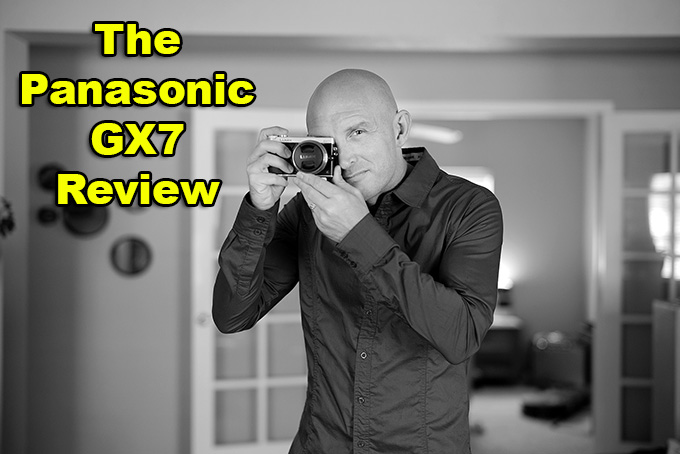
The Panasonic GX7 Review. Micro 4/3 Hits Hard in 2013!
NOTE: I am and was well aware that the lens cap is on in the above image. This was done purposely to show the LUMIX lens cap for the GX7 review. Image was taken with the Leica M and 50 Lux, NOT the camera I am holding of course.
WHAT A YEAR IT HAS BEEN! Wow! It seems like this year has FLOWN by as it was about one year ago when I was talking about the new Sony RX1 and freaking out at how far tech has come in the digital camera world. One full year and I have been so busy with this site it seems like it was just a few weeks ago when I was shooting the Zombie walk last October using the OM-D E-M5.
Micro 4/3 has been one of the solid offerings in the mirrorless camera world and I have NOT been shy about professing some love for this system. When I sit back and think about it, today in 2013, Micro 4/3 is kicking some serious behind. With the new OMD E-M1 and the GX7, we have two jaw droppingly good mirrorless cameras that can take advantage of some of the best small prime lenses on the market next to Leica.
[ad#Adsense Blog Sq Embed Image]
Yes, I did just say that!
In the world of small high quality lenses, Leica is #1 but these fast primes that are coming from Panasonic and Olympus are real jewels in the photography world and are some of the best I have shot with from any system. You have everything from fisheye to super wides to fast 35, 50 and 75mm to superfast tough as nails f/0.95 uber fast lenses. Shallow DOF is easy today with Micro 4/3 and the DOF naysayers can no longer say that this system can not deliver shallow depth of field. It can easily do so with the following lenses – the 25 1.4, the 25 0.95, the 42.5 0.95, the 45 1.8, 60 Macro and 75 1.8, just a few of the Bokeh monsters of Micro 4/3. Coming soon is a new Panasonic lens called the “Nocticron” which takes the Leica names and blends them into a Noctilux/Summicron hybrid with an 85mm portrait equavilent F/ 1.2 lens. This lens should be a masterpiece. I hope so. It will also be quite expensive.
Wide open at f/0.95 with close focus, something a Leica could never do. The 25 0.95
It has taken a few years but in 2013 there are not too many negative things one can say about the Micro 4/3 system. These new breed of cameras deliver in all areas, and for me, surpass other mirrorless cameras with APS-C sensors due to speed, dependability, usability, blazing AF, and very good ISO performance. Micro 4/3 is sort of “sweet spot” because due to the smaller sensor we get that faster and more accurate AF performance. It seems that the larger the sensor, the slower the AF. So todays Micro 4/3 is not yesterdays Micro 4/3. When compared to a Fuji X Trans APS-C sensor, these new breed Micro 4/3 sensors GET MIGHTY CLOSE, some would say, easily meet them in quality.
Panasonic GX7 – Voigtlander 25 0.95 at 1.4 – Alien Skin film filter applied. When using these fast 0.95 lenses with Micro 4/3, the possibilities are only limited by your imagination.
My Panasonic Micro 4/3 History
About 4-5 years ago Panasonic released the GF1, the 1st Micro 4/3 mirrorless offering coming in just before the Olympus PEN E-P1. Even today, years later, there are MANY shooters using that same GF1 without fail or problems. That camera was and still is wonderful though the performance is getting a little “old” with ISO noise and slower AF performance when compared to what we have today. I reviewed that GF1 back in the day and loved it. Sadly, that review is long gone as it was on Version 1 of this site back on an old Apple iWeb server but it is easy to sum up. I loved it back then, it was a real jewel and the 1st in what was to become the “Mirrorless Movement”
The original Panasonic GF1. While a great camera for its time, the new GX7 is a huge improvement in every way.
To make a long story short, Panasonic started something really good with that GF1 and Olympus soon followed with the PEN E-P1. Back in those days we had a couple of slow kit zooms and one faster prime, the Panasonic 20 1.7 lens. I did review that lens HERE and it has been somewhat of a legend in the Micro 4/3 world. Small, fast, sharp, and with a very pleasing image quality it is hard to fault the little 20 1.7. Now it comes in a Version II with build improvements as well (my review of version II is HERE) and is still one of my all time recommended lenses for Micro 4/2, no matter if you shoot Panasonic or Olympus.
Shot with the 20 1.7 II at ISO 400
In fact, it is my belief that ANYONE shooting Micro 4/3 should own this 20 1.7 lens. The size, weight and performance exceed the cost though the AF is a little on the slower side when compared to other Micro 4/3 lenses. (Amazon sells it HERE).
The 20 1.7 II wide open on the GX7 – ISO 3200 in a normally lit hotel convention center. ISO 3200! Micro 4/3 has never looked this good at high ISO.
After the success of the GF1, Panasonic rolled on and released camera after camera including the DSLR styled G and GH series, which ended up becoming more tuned in for video work. I reviewed and enjoyed the Panasonic G2 (can see that HERE) but sadly, that was the last Panasonic camera that I felt was worthy to review or talk about. I have shot with them ALL of course but the GF3 and all of those silly little “micro GF” cameras were not very good IMO. To me it seemed like Panasonic lost their way and started trying to appeal to the masses with cute little dumbed down cameras. Too bad, because they did not sell well and ended up being cleared out at stores like Target and Best buy for $199 with kit lens. While Olympus rolled on with their premium PEN series Panasonic was releasing stinker after stinker and at the time, it appeared they abandoned the enthusiast market for Micro 4/3 in regards to a good solid body solution.
The 20 1.7II with the GX7, up close and personal – shot at f/1.7
I often wondered why-oh-why did Panasonic release the amazing GF1, which was a real “Photographers Camera” and then choose to follow it up with silly micro sized releases. A couple of years rolled by and Panasonic seemed to make a come back with the much talked about and touted GX1. Yep, this was to be a return to form for Panasonic and was the REAL follow up to the GF1. When one came my way to review I was also reviewing the Olympus E-P3 at the same time (which I adored) and after doing some side by sides I realized that even the GX1 fell short for my tastes. Soon, this was yet another camera being cleared out on Amazon. It had its fans, but I knew Panasonic had more, and I made it clear that I felt the E-P3 was better, because to me, it clearly was..again, for my own tastes. The GX1 sold well, but not amazingly well.
So Panasonic went on releasing cameras like the G3 and GH3, which were nice, but we were still missing that little square “rangefinder-esque” GF1 style camera and man oh man was I rooting for them to release something special, and if it had a built in EVF, even the better.
The GX7 with Voigtlander 25 1.4 at f/2.8 – click it for larger.
Enter the Panasonic GX7 – A true return to form
So finally in 2013 we all heard about the new Panasonic GX7 and rumor was that it has a built-in EVF, GF1 styling and all new and improved sensor and performance, including in body image stabilisation and fast Auto Focus. Wooooo Hoooo I thought! FINALLY, A sexy beast of a Micro 4/3! Sure, we had the new and exciting Olympus OM-D E-M5 which was taking the Micro 4/3 world by storm (and rightfully so) but this was the mighty comeback of the “Photographers Camera”, the new GX7.
So of course as soon as it was official, I placed my pre-order for one just so I could get one as soon as I could for review. Some camera companies will send me review samples but Panasonic has never sent me a review sample directly. In fact, Panasonic is the only camera company that I do not have a contact at for review samples. Not sure why, but that is just how it has been, so I just had to order one for myself (which isn’t so bad, is it)?
So the moment it arrived I unboxed it and took a look. Pretty snazzy huh? It has an EVF, sweet style and design, superb feel in the hand and is the best looking, feeling and performing Panasonic Micro 4/3 to date.
But just as the Panasonic was being shipped Olympus was making huge noise with the release of their all new Pro series E-M1 micro 4/3 camera that had all kinds of features that this new Panasonic lacked. A pro build, weatherproof, shockproof and freezeproof, In body class leading 5-Axis IS, Dual Fast AF with Phase and Contrast detect as well as a HUGE built-in EVF that puts all other mirrorless EVF’s to shame. The Olympus also had a new sensor, live time feature, the ability to use legacy 4/3 glass with fast AF and all kinds of amazing things. A truly revolutionary product for Micro 4/3. The GX7 is evolutionary no question but Olympus decided to go for it with the E-M1.
While the Panasonic lacks many of the E-M1 features, for many of us, this is for the best. Let me explain.
Not everyone needs all of these fancy features and to many, simplicity is what it is all about. All one needs to take a photo is a camera, lens and a shutter button. Do we really needs a million bells and whistles? I admit, I have BOTH of these cameras in my house right now, the GX7 and E-M1 and after extensive use, I would 100% go for the E-M1..FOR ME. I love the feel, the build, the 5-Axis and even Live Time feature. I also feel the IQ is a little more “refined” in color and rendering not to mention the flawless and amazing WiFi implementation.
But this comes at a price. The E-M1 is $500 more than the GX7.
For that difference one could buy the awesome 25 1.4 Panasonic lens. So this is not a decision to make lightly. In the real world, the GX7 is just as capable in IQ and image taking as the E-M1 so what you choose should depend on what you need and want. If you do not need all of those snazzy features of the E-M1, the GX7 is the next best in the Micro 4/3 world.
My real world experience shooting with the GX7
After shooting with this camera for a while I have grown to really enjoy shooting with it. Below is a list of the things one should know about the GX7, because it is one hell of a camera and at $899 for the body or $999 for the body and kit lens, it is a GREAT buy and well worth the cost.
The Build and Feel
The Panasonic GX7 did not disappoint when it came to the feel of the camera. In my hand it felt fantastic. The grip is just large enough to fit around my fingers and rest in my palm comfortably. When holding the camera I can easily use the built in EVF to frame and shoot. In regards to the build quality, the GX7, in my opinion, is very good. If I compare it to the classic GF1, GX1 or even Olympus E-P3 the build is equal to those cameras.
It is solid and my only complaints about the build would be that some of the dials and buttons feel a little bit on the cheaper side. Plastic.
If I compare the build and feel side by side with the Olympus E-M1 or E-P5, the E-M1 and E-P5 wins easily. They feels more solid, heftier, and the dials and buttons are smooth and solid. No plasticky feel with the E-M1/E-P5. But again, $500 more for the Olympus E-M1, so it should feel a bit better made and there is no built in EVF with the snazzy E-P5, so there are always trade offs.
Overall, the GX7 gets a B for Build because when comparing to all Micro 4/3 cameras or even other mirrorless system cameras it is about equal, 2nd only to the new and top of the line E-M1 .
OOC JPEG at ISO 2000 WITH in camera NR
The AF speed
The AF speed in the new GX7 has been touted by Panasonic as being blazing fast and I have to say, I have no disappointments with the AF of the camera. When using it with the kit zoom, it is lightning quick. When using it with the 20 1.7II it was slow to AF indoors. Sometimes taking a second to lock or longer. In comparison, the E-M1 with the 17 1.8 was lightning quick in the same indoor lighting and the E-M1 with the 20 1.7II was quicker than the GX7 by a small margin.
But with the right lens it is fast, accurate and never once in my use did it miss AF or fail to lock. Even in low light it found the focus and nailed it. Compared to the E-M1, it is a tad slower in general. Compared to the E-M5, it is equal or slightly faster. At this level it is plenty fast enough.
When I say the AF is fast, it is for static subjects. For moving or tracking, this may not cut it for you. So sports shooters who want to head to M 4/3, I would suggest the E-M1 but even so, Micro 4/3 is not the format for pro sports shooters as DSLRs still have the edge in THIS area.
This camera will AF faster than any Fuji body, any Sony body and any other APS-C mirrorless body. But each lens will give you a different AF performance level. The 20 1.7 is one of the slower lenses but it is still a beautiful lens to use and own. Slap on a 12-35 and you will be amazed at the speed.
The 20 1.7II may not be the fastest to AF but it has amazing IQ 🙂
The HIGH ISO performance
As for high ISO the GX7 is as good as the new E-M1 when it comes to bumping up the ISO and dimming the lights for some night shooting. With any Micro 4/3 camera you will have more noise than any APS-C sensor but in reality, not much more. These new sensors are better than ever (for Micro 4/3) when it comes to high ISO and ISO 3200 is usable and actually not so bad. Below see some ISO samples and comparison with the E-M1. The WB of the E-M1 is a bit better than the GX7 in these samples. Zero noise reduction here, zero.
As you can see, ISO 3200 as an OOC file does not look that bad resized. But pixel peepers who view their images at 100% on a computer screen will see the noise 🙂
HIGH ISO CROPS
To me the high ISO capabilities are similar between the two cameras and any differences that are there would not show up in print.
–
The Usability of the GX7
Micro 4/3 cameras have usually been good for usability. The very 1st cameras, the E-P1 and GF1 were not so good by todays standards but today..it is an all new story. These cameras are fast, responsive and mean business. In fact, I recently shot with a Canon 6D and a couple of fast primes. The GX7 can focus faster than that 6D did when using the 85L and 35 1.4. The GX7 is also just as responsive.
Menus are easy to navigate and settings are simple. Large easy to read text and a simple navigation mean JOY of use 🙂
The GX7 also now has IN BODY Image Satbilsation. This is welcome as previous bodies only had IS in the lenses. The only bummer is that manual lenses/3rd party lenses are not compatible with the IS when shooting video. With the Olympus bodies, you can use the in body IS with all lenses. I am hoping Panasonic fixes this in future FW updates.
The EVF
The EVF on the GX7 is good, but far from perfect. I am thrilled that there is an EVF but after shooting the E-M1, it is obvious there is a quality difference between the two. Still, its a good EVF though in the GX7 I have been shooting the white balance in the EVF is WAY OFF when compared to the LCD screen. Looking through the EVF I sometimes see off color and orangy color but when I review on the LCD it looks perfect. Not sure why this is the case but it is annoying when using because you think you are way off with your white balance or exposure only to find out it is just what you are seeing through the EVF. I prefer a what you see is what you get experience.
I love love love the fact that the EVF swivels up as I have used it numerous times now in this fashion. Looking down into the EVF while holding the camera lower is a nice way to shoot sometimes. With the GX7 you can do this. When you are done it flips right down and the camera retains the clean lines. I love the fact that you can do this and there is no other camera made where this is possible.
The Lenses
As I have stated many times on this blog, Micro 4/3 lenses are superb. Take a look at my faves HERE.
–
The Silent Shutter Mode
The GX7 has an electronic Shutter mode for those times when you want to be silent. The Nikon V1 had this years ago and am happy to see it in the GX7. For those times when you want or need 100% silence, you can activate the electronic shutter and be as stealthy as a ninja 🙂
–
The Video
The GX7 does indeed have full HD video capabilities. 1080p at 24 or 60 frames per second. From my quick tests, the video looks great. I have some sample videos shot with the camera in the video I posted a little ways up. I am not a huge video guy but Panasonic always does a good job in this area. If I were shooting pro video I would not be using a GX7 but the video I see is plenty good enough for personal use, youtube or fun projects.
One thing that I did not like is that in body IS does not work with manual lenses like Leica or 3rd party manual focus lenses.
The Value
For $999 with a kit zoom lens, the GX7 is a best buy for Micro 4/3 bodies if you want something on the higher end of Micro 4/3. Along with the older Olympus E-M5 it is highly recommended in the $1000 price range. But what about the older E-M5? What camera would I take between the GX7 and that older Olympus? Well, between those two, it is a draw for me. I prefer the feel of the GX7 but the E-M5 is wonderful. I would probably lean GX7 if buying fresh today between those two but both are great. Still, to be fair, if starting fresh in Micro 4/3 today I would buy the E-M1 and call it a day. Bottom line? You can not make a WRONG decision here. Go with your gut 🙂
–
VS the E-M1
While the GX7 is the best Panasonic Micro 4/3 to date for taking photos, the E-M1 is the best Olympus to date for Micro 4/3 in general. Which is better? Well, my opinion is that the E-M1 is better but both can take an amazing photo. It’s all up to you, the photographer. Your eye, your mind, your style. Looking at the image above, which camera tugs at your soul the most..just by looks alone?
Some will choose the E-M1, others the GX7. But looks are not the whole story. While I prefer the sexy clean lines of the GX7, in the real world I find the E-M1 to be one incredible camera. My full review will be here soon for it but to put things into perspective, what makes it for me is the incredible 5-Axis IS, weather seal, huge and beautiful EVF and the ergonomics and control. It is one advanced camera and even the WiFi rocks. I also prefer the color from the Olympus.
But at the end of the day, as I said earlier in this review, it all comes down to your wants and needs. You may not care or need 5-Axis, weather sealing or the other features of the E-M1. If that is the case, saving some cash on the GX7 would be the thing to do. Both are excellent. For $500 more the E-M1 is indeed the better camera technically but the GX7 is no slouch, not at all.
Some may wonder why I keep comparing this to the E-M1. Well, I have to do this. The E-M1 is the other brand new micro 4/3 body and it is a better body, though at $500 more. I want the readers to be aware of this in case the Olympus is more to their liking. I would hate to read a review, buy a camera, then find out the next day there is something that I may have liked better.
Even so, some will prefer the GX7 as it is also a superb tool. It comes down to features, and that is all.
The E-M1 can be seen here for $1399 and the GX7 here for $998 with lens.
Pros and Cons of the GX7
Pros
- Nice size and feel
- LOVE the new EVF, kudos to Panasonic for putting it in
- AF is fast, almost as fast as the E-M1. Same as E-M5
- Camera design is awesomely cool
- Swivel touch screen LCD is nice
- High ISO VERY usable to 3200 ISO
- Multitude of lenses available
- Price is right at $899 for the body only, $99 extra for kit lens
- Finally, the worthy follow up to the GF1
- FOCUS PEAKING!
- The GX7 has a silent electronic shutter mode ala Nikon V1
Cons
- Some dials and buttons feel cheap
- No in body IS during video with manual lenses
- In body IS is nice, but not as good as 5-Axis in the E-M1 or E-M5
- Not available in all black in the USA
- White Balance and Color is off in the EVF at times when it is perfect on the LCD
My final word on the Panasonic GX7
After shooting the GX7 and E-M1 side by side for a while I can honestly say that I fell in love with one of them, and that was the E-M1, but I also loved shooting the GX7.
As always, it’s personal preference. IQ wise they are neck and neck so go with what you LIKE. I found the GX7 to be the best Panasonic Micro 4/3 made to date. Nice build, nice size, nice weight, great EVF that tilts up and down for more versatility and the touch screen LCD with all of the modern speed you can ask for.
The Auto Focus is fast on the GX7 but not any faster than the Olympus E-M5 or E-P5. The Battery life is good, had no issues with battery drain and shot a whole weekend on one charge. When mated with the lovely 20 1.7 II this makes for a nice compact lean mean sexy shooting machine. The Lumix GX7 is up there with the best of Micro 4/3.
At $998 for the body and Kit Zoom, it is well worth the cost if you want to get into Micro 4/3 while getting superb quality while spending under a grand.
Not much else I can say on the GX7, I like it.
Some have asked me about the GX7 vs the E-P5. Well, the E-P5 is beautiful, in and out. It is built to a nice standard, very hefty and solid with a gorgeous retro design, stellar LCD, amazing 5-Axis IS and features as well as having that PEN Mojo. My only issue with the PEN E-P5 is there is no integrated EVF! If Olympus would have put one in, it would be no contest..E-P5. Its a better made camera, feels better in my hand and I prefer the design as well. I just can not excuse Olympus for leaving it without an EVF in 2013. The PEN needs an EVF.
Panasonic listened to the demands of the enthusiast (something Sony has been doing for 2 years now) and made the camera we wanted to see made for Micro 4/3 at a decent price point. While there are many things I prefer on the E-P5, I have to say that I would probably choose the GX7 over it as I find it more enjoyable to shoot with. Still, I do like the E-P5 very much as I have always been a huge PEN fan. I am hoping that in 2014 or 2015 we will see one with a VF4 embedded in the body 🙂
With that said, look for my Olympus E-M1 review in about a week 🙂
Two with the Leica 50 Summilux ASPH on the GX7
WHERE TO BUY!
You can buy the Panasonic GX7 at Amazom or B&H Photo, my two favorite big time shops. Direct links are below:
Buy the Panasonic GX7 at Amazon with the 14-42 Kit Zoom HERE
Buy the Panasonic GX7 at Amazon – Body only
Buy the Panasonic GX7 at B&H Photo with Kit Lens HERE
Buy the Panasonic GX7 body only at B&H HERE
Buy the Voigtlander 25 0.95 Lens HERE – (LOVE this lens)!
ISO 2000 with the Kit Zoom – NO NR
–
With a Leica 50 Summilux ASPH at f/2
and the box..
HELP ME TO KEEP THIS SITE GOING AND GROWING!! IT’S EASY TO HELP OUT & I CAN USE ALL THE HELP I CAN GET!
PLEASE Remember, anytime you follow my links here and buy from B&H or AMAZON, this helps to keep my site going. If it was not for these links, there would be no way to fund this site (and the cost these days to keep it going is pretty damn high), so I thank you in advance if you visit these links. I thank you more if you make a purchase! I have nifty search bars at the upper right of each page so you easily search for something at either store! I currently spend 10-14 hours a day working on this site and the only way that I can pay for it is with your help, so thank you! Currently my traffic has been increasing but my funds to pay for the site has been decreasing, so any help would be GREATLY appreciated!
Even if you buy baby food, napkins or toothpicks at Amazon it helps this site, and you do not pay anything extra by using the links here. Again, you pay nothing extra by using my links, it is just a way to help support this site, so again, I thank you in advance ![]() More info is here on how you can help even if you are NOT in the USA as I have Amazon links to Germany, United Kingdom and Canada as well!
More info is here on how you can help even if you are NOT in the USA as I have Amazon links to Germany, United Kingdom and Canada as well!
If you enjoyed this article/review, feel free to leave a comment at the bottom of this page and also be sure to join me on twitter, my facebook fan page and now GOOGLE +!
Also, you can subscribe to my feed at my subscribe page HERE and read these posts in your browser or news reader!

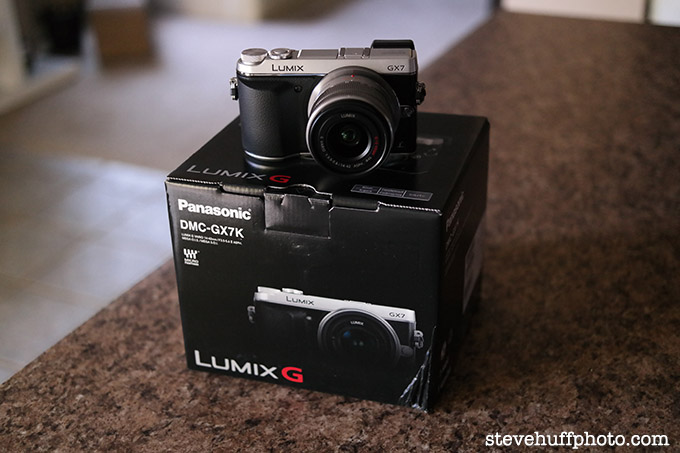


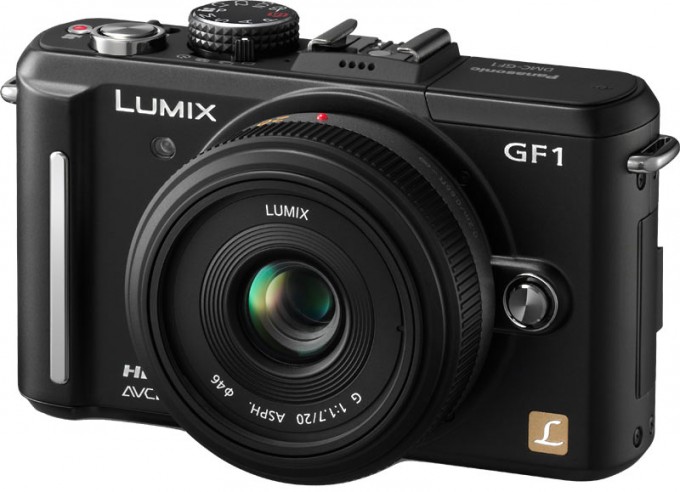




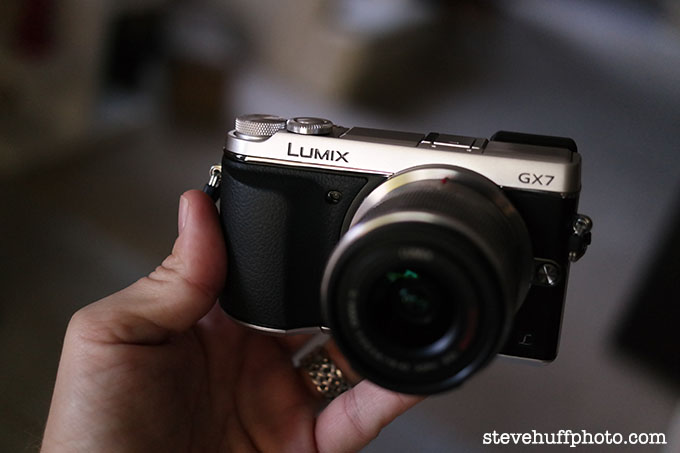

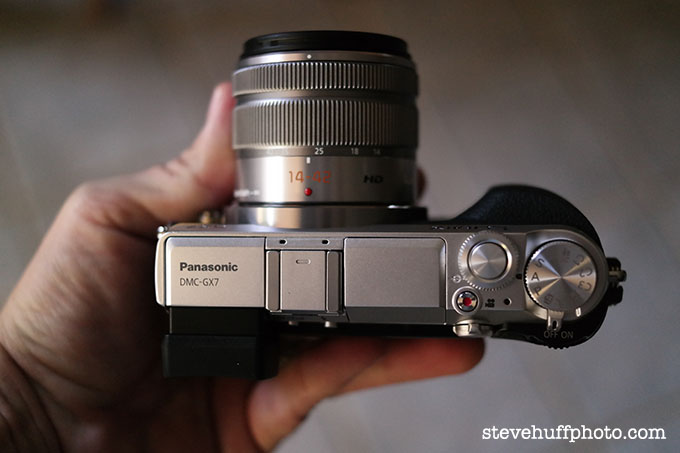


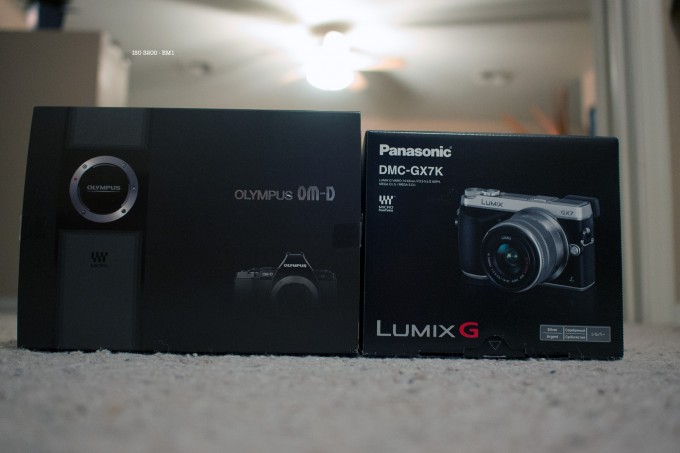


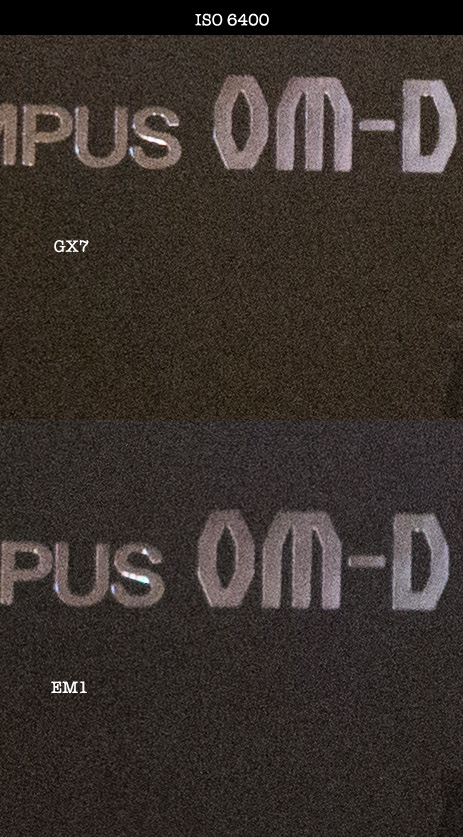

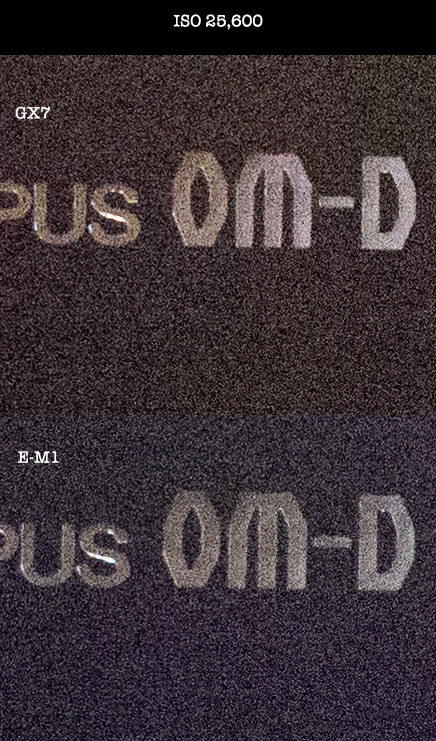



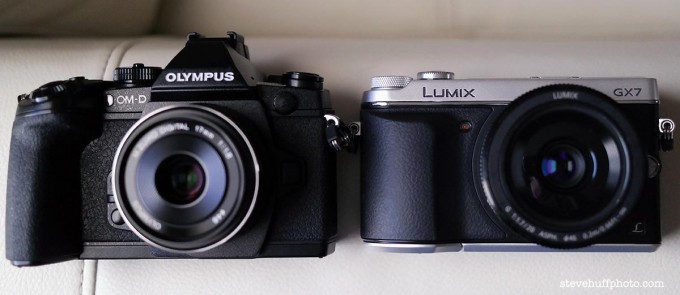
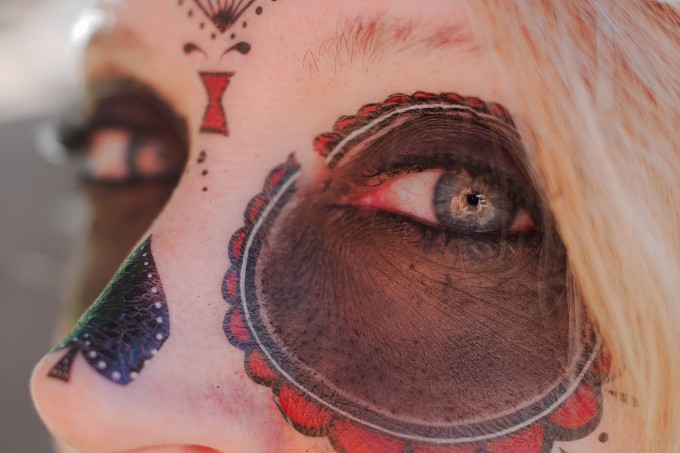
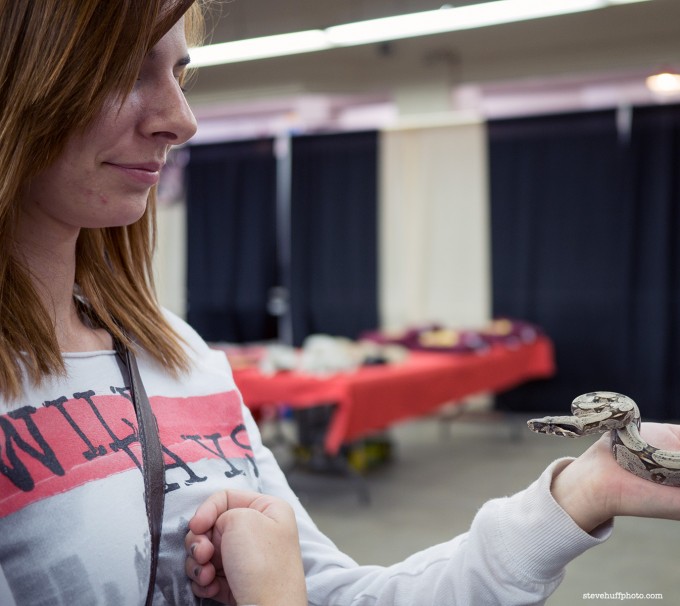



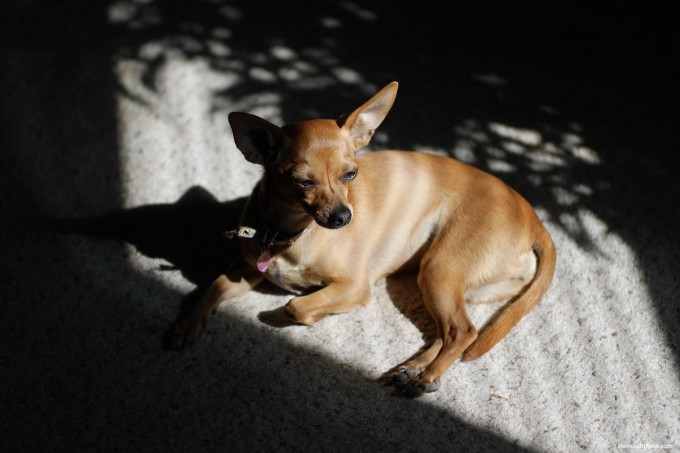
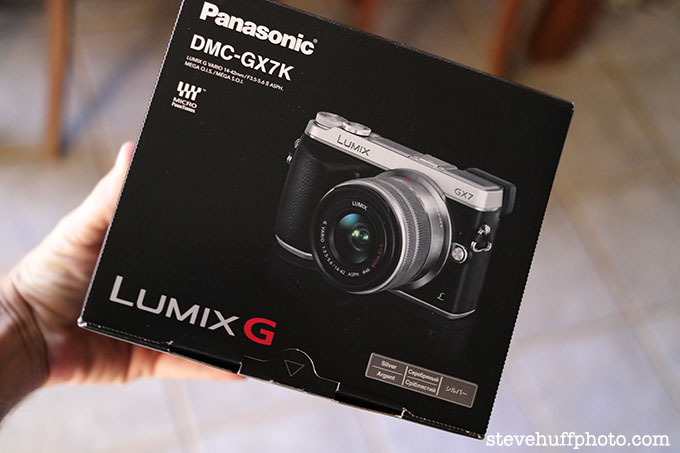

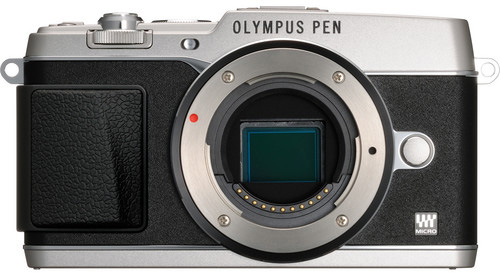
Hi Steve
Great fan of your website and a recent purchaser of a second hand Gx7 in 2017 for £200 / $260. Interesting looking at your review in 2017. The EM-1 really holds its value still today (£400 plus) – but now the Gx7 makes a great deal when its this cheap, its flaws (smallish viewfinder in my mind) – and it still takes really sharp images. Ive paired it with a Panasonic Leica 15mm f1,7 I got 2nd hand, and it takes great images – really sharp, and I feel that sensor technology hasn’t changed that much – 16mp versus 20mp.
Its great that you champion m4/3 because I feel that many put it down over way more expensive cameras. Until recently I had a Sony A7, which is fantastic, but sony’s lenses are so expensive – so dear that I could only afford to use manual focus legacy lenses, which whilst fun – at times I miss autofocus.
Anyway, what ive missed is a small camera I can carry with me everywhere, with fast autofocus and good enough photo quality. Last summer a friend lent me a Olympus EP1 and 17mm f2.8 for a trip to Thailand . Having a small camera in my hand at all times let me capture some great images – the only criticism of the EP1 being the slow autofocus speed and bad noise at iso 6400.
The Gx7 has much better autofocus and iso performance – and a viewfinder. I may miss the depth of field and bokeh of the A7 – but I have a second hand oly 45mm f1.8 lens coming to make up.
I becoming a convert of Micro four thirds – especially if paired with a nice lens. The lenses are affordable and the bodies are so cheap.
Anyway – thanks for the great reviews
Steve,
I have a set of old Konica Hexanon AR lenses, a 28MM, 50MM and 135MM. Adapters are available from the Konica mount to M43. I am not a pro, but like to mess around with a camera. Any downsides to buying a GX7 body and using these lenses? Any other mirrorless cameras you would recommend for me?
Steve, I have taken an advantage of the low price of the GX7 to add it to my GX1. The only problem is the EVF, the only way I can describe the appearance of the image inside it is very like an Andy Warhole painting, it all looks like pop art. Any ideas?
You can into the menu and adjust the color and contrast of the EVF and LCD.
Just re-reading some reviews of the GX7 – and this is a nice ‘hands-on’ review with the some really useful opinions. I’d been waiting for the new Lumix G7 to replace my G2 – but after seeing the spec. (no in-body IS, no weather sealing, no new sensor) I decided to get a deal on the GX7. $700 with the Mk 2 20mm f1.7 lens, bag and SD card. Yes the OMD-1 and now the OMD-5 Mk 2 have some advantages – but the GX7 has the same IQ for less than half the price.
For me the GX7 does all that I need – and it’s currently a bargain.
i totally agree. often, one can get easily overwhelmed by the marketing of features. i really applaud people who do not go for the latest and most expensive models but models that fit their actual (and not hypothetical) needs!
Hi, great review. How do you rate Olympus Pen E-PL7 with this one.
Like the review, thanks. And yes, it is obvious you prefer Olympus. For me the question is how much the GX7 adds to a GX1 (where-ever are the GX2,3,4,5, and 6?). And although you state a grand is a great price, i would prefer to buy the GX1 that can be had -ok used – for just 150 bucks now. Add a LVF for another 100 and you’re set.
Better ISO-performance would be good; i feel the grain is often too noticeable in my pictures. Offcourse there is software for that, but the sharpness/detail will be less. On the other hand, i dont shoot much high-iso images. With those fast lenses available there is not much need for it, unless in dark surroundings, but then any camera will render noise at high iso’s.
The great high quality and fast lenses are also why i dont care much about the IS, even if it is 100-axis. How much IS do you need really on a lightning fast 0.95 lens? Especially when the lens is 50 mm or wider. You can shoot that handheld at 1/40 th of a second minimum, with no cam-shake. A 17mm should do fine with 1/15th without IS. That should be no problem in most conditions. Mostly you would probably go with 1/50th at LEAST, to prevent subject movement being a problem.
IS is great on tele(zoom) lenses and macrolenses, apart from that it is highly overrated and on shorter focal length lenses i dont care a bit about it.
WIFI really? A camera should be camera. Not a computer and not a phone. Who wants to direct the camera with a silly phone? Just press the button.
Finally, why is there a need for new camera’s all the time? Do you really need the latest version? Or is it better to hang on to a camera a little longer, really learn it and get to know it; be able to use it blindly in the field. Photography is very old and there’s lots of famous photographers that shot with analog material, far over a century ago even. They took stunning pictures, not because their material was better, but their knowledge and creativity were. Maybe it’s better to invest in that, instead of a new camera (all the time).
Cheers from Holland
Great site- Thanks
I am looking to replace Canon 1100D with a Sony A6000 or Panasonic GX7- Use- Family/ Buildings, landscapes , occasional Cycling ( races) looking for the ‘simplest to use of these two camera
would very much welcome your view, thanks
I’m looking to replace my Canon 650D with the same options: Sony A6000 or Lumix GX7. Would appreciate your opinions on this. Thanks!
Must the “shoot without lens” setting be turned on to use Oly lenses?
I bought the Panasonic GX7 with 20mm/1.7 v2 this week. It seems to work great.
Today I tried an Olympus 45mm/1.8 but every test shot was soft.
The seller used an Olympus EP5 and all shots on that body looked sharp.
Any idea what the issue might be?
Thanks
I’d like to know what is the difference between the Silver and the Black one ??
Can you use lenses like Zeiss or Leica ??
Thanks.
No functional difference between the black and silver GX7 bodies. You will need a lens adapter to use a Zeiss or Leica lens.
Thank you.
I noticed that there are Leica-Panasonic 4/3 A/F Lenses…..are there any others ??
Micro 4/3 is what you are looking for and they are made by Panasonic and Olympus as well as some third parties such as Sigma, etc. Some Panasonic lenses are in collaboration with Leica.
At last…a camera with an EVF that doesn’t add bulk! Why didn’t someone think of this sooner? (OK, Sony did A LITTLE sooner, but not by much.) Put on a pancake lens, and this thing is a pocket-sized ninja. With the right (small) lens, nobody will even notice that you’re taking pro-quality shots! Very inconspicuous. And good for Panasonic for finally including in-body image stabilization so I can realistically use my Olympus 40-150mm zoom with it.
I. Want. This. Camera.
Hi Steve, I’m torn between a NEX 7 and a GX 7. In both reviews you are enthousiastic so which one you’d recommend?
I have had both and can tell you hands down the gx7 is a much better camera with much better glass at a more affordable price. I highly recommend.
Well, the GX7 is Micro 4/3, the Sony is APS-C. Two different size sensors. BUT it comes down to lenses. This is where M 4/3 shines and beats all APS-C bodies, yes, even Fuji IMO. The NEX-7 is now a little old with lackluster ISO performance when compared to todays cameras. If it were me, I would take the GX7 today over the NEX.
Hi Steve, I have been a huge fan of GF1 like you. Then I step up to GX1. But now I am tempted to buy Fuji EX1..but suddenly came along GX7. So in your honest opinion which do think are best for me. I mainly use the 20 F/1.7 pancake lens and some voigtlander to go along with the body. Thanks and can’t wait to hear what you think…
Guys – Please bear in mind I am a novice/beginner and growing from Point and Shoot and working to get the kit sorted quickly to start with.
2 options to chose from !
1. G 20mm F1.7 II – Prime Lens – Highly recommended – Usually expensive kit option – Also Expensive than the option 2 if you buy separate (GBP 225 Approx) – Cost of Kit = GBP680
2. G VARIO 14-42mm F3.5-5.6 II – Most commonly offered Kit lens. Cheaper to buy separate compare to option 1.(GBP 100) – Cost of Kit = GBP750
On just one one website I have managed to find the price of option 1 kit cheaper than the option 2.
So the question is selecting one of the 2 options:
1. Buy above option 1 kit only for GBP 680
2. Buy above option 2 kit only for GBP750
3. Buy option 1 kit and G VARIO 14-42mm F3.5-5.6 II lens for GBP 780
Please could you help.
Regards
I recommend kit 1. Shooting with a single fixed focal length is a great exercise for a beginner and will make you a better photographer. I did that for a year back with the GF-1 20mm kit. If you plan on shooting a lot of video though, the 14-42 is a good cheap option because of its stabilization and good-enough sharpness. In that case I’d buy it separately (option 3). Here’s some example video from the GX7 with it: http://www.youtube.com/watch?v=ug_ryWXT-X0
Can i ask for comparis between gx7 and nex-6 . Who of both is faster to shoot ? Which is made better video ?
Has anyone used GX7 files to successfully make excellent sharp large prints up to 20×30 inches. Can it be done with such a small sensor ?
I’m also wanting to know whether it has eyepiece diopter adjustment please
Hi Steve,
Do you know if the touch screen option can be turned off on the GX7.
Thanks
Does the gx7 evf have diopter adjustability?
Hi Steve, i am about to buy the GX7 thanks to your review!!
but i wonder which kit , the 14-42 or the 20 mm one?
what would you advise me?
i am an amateur and really don’t know wich one to choose.
i saw you recommend the 25 1.4 Panasonic lens, but i am not as good as that to invest in this lens at this time.
may be when i’ll be able to take some nice shot.
but at the moment i will stick with one of the two existing kit on the market
thanks in advance for your help !
Manuel
Hi Steve,
From a price point of view it begs the question of E-M5 vs GX7. I know E-M5 is last year’s story 🙂 but they are both similarly priced and performance seems to be very close. Yes, GX7 is new, but E-M5 is not far behind, in fact still maybe better in some aspects. One would even imagine that Olympus continue E-M5 for this reason to complete in that GX7 market segment.
I was wondering what’s your thoughts on this? Which one would you pick if you were given a choice. I’m actually considering buy one of these cameras. E-M1 is little too expensive and honestly, feels little too big for a MFT too although this could just be my taste.
Thanks in advance,.
EM5 – IBIS is superb. GX7 – faster AF, capable of sports and birds in flight (with the Oly 75-300).
Both excellent!
Both excellent cameras, indeed! I would have loved to have purchased the EM5, but it was too small for my hands and I can’t see the entire image in the EVF.
E-M1 is larger, much better grip, buttons and huge EVF. Give it a shot, you wont be disappointed.
Looked at the E-M1, nice camera but I cannot see the entire image in the EVF while wearing my glasses. The GX7 EVF is evenly illuminated and clear when viewed my glasses. It is the only u4/3 EVF that works for me – I’ve tried them all. The E-M1 is another step forward for the u4/3 world!
Between the Olympus OMD-EM1, the Olympus PL5, and the Panasonic GX7 — which is the easiest to learn how to operate? Though I’m looking for great image and camera quality, I’m moving up from a point and shoot and need a menu system that’s least confusing.
I have the beautiful champagne gold & ivory Leica C
The GX7 and Leica 50 Summilux ASPH combo photo’s are just beautiful! Could you post a picture of what must be the coolest looking camera combination out there at the moment (except actual Leica bodys of course)?
“I felt that the top plate dials and viewfinder shell was of poor quality”
The viewfinder shell is your basic plastic found on 99% of today’s cameras. The top plate dials are nicely knurled metal.
Well they feel cheaper than other cameras I have here: E-M1, RX1, etc. Was hoping for a bit more sturdiness. I am not the only one who has mentioned this, many have over the past week or two.
Well, I don’t know how much sturdier they can be. I don’t want to have to use a pair of pliers to change settings. Has it really come down to this…criticizing the degree of sturdiness on metal knobs?
that is funny, first time I see a comment telling that Fuji X series cameras are crap!
So many people say they are built like a tank. Are they light and therefore feel “emty” when compared to an Oly? Maybe but it is just feeling and real atvantage is lower weight hanging on your neck.
BTW – I am still deciding which system (Oly or Fuji) to select going from my Pentax DSLR. I like them both but prefer Fuji for its purity, Fuji colors (yes!) and simplicity and high quality but yet relatively cheap glass (zoom). Sorry for my poor english.
I know the E-M5 and E-M1 are supposed to be retro styled (hence the OM prefix), but for crying out loud does anybody actually like the big bump out on the top for the EVF? It is so much nicer to use on the NEX-6 and 7 and now the GX7 on the side so that you don’t get nose grease all over the screen! Sadly, I can’t see Oly giving up this center bump “feature” any time soon.
Hi , I had a look at a GX7 yesterday in Jessops UK. The camera sports a great design however I felt that the top plate dials and viewfinder shell was of poor quality – No where near as robust as those on the GX1 or indeed the Fuji X100s
I, for one, am grateful for the comparison of the GX7 to the E-M1. I want to upgrade from an old Canon Rebel and have decided to go with one of these two new models. One question that rarely seems to be addressed in reviews is which camera gives the most accurate – not the “most pleasing” – color rendition. In the high ISO crops the comparisons showed two very different colors. At least to me, the GX7 crop looked brownish-black while the E-M1 looked bluish-black. Are these or other differences seen in pictures taken under real world conditions? While I realize there is a certain amount of subjectivity involved, I would be interested in which camera gives the most accurate color. I ask because I take many outdoor shots and want greens and especially gray greens to stay accurate, even under gray skies, instead of taking on too much magenta, which can impart a slightly brownish, or “dirty” look. Maybe this question is more about different white balance settings and their accuracy? I don’t shoot raw so this is important to me. Any guidance you can give is really appreciated.
I already own a GF1 and have the same requirements about color renditions. As mentioned above skin tones are wrong, and I also don’t like the greens (too brown). I wonder if it can be fixed with a better lens: I only own the pany 14 and 20 pancakes, they are sharp but the colors are not wonderful… But for what I see in this review I’m afraid the gx7 won’t be better. As I like the form factor very much, do you think as sony nex-6 would be the perfect one between oly and lumix?
The combination GX7 + 75-300 is much faster focusing than the EM5 + 75-300. The AFC speed, combined with the good high ISO performance, means that the GX7 + 75-300 is very capable for BIF and outdoor action photography.
An image comparison between the GF1 and the GX7 would be interesting, just to see what differences there have been over the past 4-5 years in picture quality…I wonder if they really are that significant ?
Thanks Steve for your review.
Being a concert shooter, I am very interested in buying the GX7 because I am very attracted by the electronic shutter (no noise at all which is very important for me, of course) and the very light 35-100 f2.8. I am fed up of carrying a heavy 70-200 2.8 with a DSLR camera!
I own a GF1 of which I appreciated the AF, but I hated the skin tone rendering pointing toward magenta, and the uncapability of sustaining the highlights. What is your opinion about these two aspects regarding the GX7?
P.S. I always shoot RAW.
thanks
Antonio
Well, highlight retention is much improved in the Micro 4/3 sensors today. As for color, the GX7 seems to have a cool color character. Cant say that I found skin tones to be Magenta, but in any case, it is a big step up from a GF1 in all areas.
The GX7 EVF is the only Micro 4/3 EVF that I am able to see the entire image while wearing my glasses. This applies to all Olympus and Panasonic built in or accessory EVFs. I have not looked through the E-M1 EVF yet.
Negative on the EM1 too. I am unable to see the whole image with my glasses on.
I just revisited this site and looked again at high iso comparison level. oh man at 1600 up they both noisy ( I wonder to see their performance under 1600 too but Steve didn’t show it) ,how can I spend much money for that kind of noisy cameras, I recall the samples of cheaper and bulkier K01 at high iso, even at 6400 it looked far better and usable file.
They are not far off from the class leading Fuji X bodies at high ISO. You must have missed this:
http://www.stevehuffphoto.com/2013/10/04/crazy-comparison-part-2-fuji-x-m1-leica-m-240-olympus-e-m1-and-panasonic-gx7/
Remember, I shoot in LOW light, without any noise reduction. I turn it off 100%. Using it in low light shows the true performance at high ISO and even a K01 would be showing plenty of noise in this test.
A real photo at ISO 3200 in indoor conditions without NR
http://www.stevehuffphoto.com/wp-content/uploads/2013/10/P9960027.jpg
Hi Steve,
Any shutter shock experienced with the GX7? Another site recently reported the EP5 had evidence of shutter shock at certain speeds. I was wondering if it has to to with the Rangefinder style camera and perhaps the “dirty diaper hold”… Tks.
The E-P5 looks like a nice camera, but without the EVF it is grossly overpriced compared to the GX7. Hell, it’s grossly overpriced in general.
The E-P5 is priced about right at $1300 for body, 17 1.8 lens and EVF-4. Body is well worth $800-$900 easily. Once you feel it, hold it and use it you would see that is true. It’s leagues faster, more advanced and better made than the X-Pro 1, yet cheaper. My niggle is that they should have put the VF4 in the body like they did with teh E-M1. But you can add it and the kit price is priced very well for what you get.
Hey Steve, this is a great site! I really like your user-side approach to reviewing cameras. I wonder, did you ever get to try the Panasonic G6? What’s your opinion on that one? Thank you!
when you all talk about the quality feel what do you actually mean? Do you mean it is just heavy when compared to e.g. X-E1? Or it is finished to create an impression on you? Or you mean it is realy solid? And if so how did you evaluated this? I do not have neither Pana nor Fuji nor Oly bodies and read through the forums that the X-E1 is a solid camera (really solid bulid camera) so I wonder what is the solid feeling of the Pana many of you bring here? Is this like solid feeling of a VW car interior decribed by German automagazines which loose direct confrontation with e.g. a Volvo interior which mechanically is a class higher?
I own a X-Pro 1 and XE-1, and an Olympus EP-1 (4 years old). I both consider the Fuji bodies and lenses (except the 14mm) to feel cheap (hollow, assembly problems) and actually be cheaply built. You can check the XE-1 bottom, and see this : in my case, the two parts are not evenly assembled.
The feel being subjective, what I can say about the built is the following :
– cheap materials (cheap plastic plugs on the X-Pro1 that fall out, camera strap wore out on the edge after a few months, rubber grip turned grey after a few months
– aperture rings on the 18mm/35mm are way to loose and become looser
– lens hood caps fall off if you just turn the camera down, lens caps fall off when you walk with the camera, lens hoods are not solidly attached
– even though I carry the camera in a bag, dust infiltrates and paint comes off very easily on the X-Pro
– shutter on X-Pro had to be replaced after a few months
Compared to that, the Olympus EP-1 which I have used very intensely for over 3 years feels and behaves like a brick. It resisted light shocks without damage, the wheels are still very solid and tight, I could carry it wrapped in a fabric inside a bag, which I can’t do with the Fuji as dust infiltrates the lens MF and aperture ring. I can wear the Pen around the neck without worrying to damage it or loose parts.
I think Fuji tries really hard to make light bodies and lenses, and chose on some parts the cheapest available material – though both cameras and primes are “Made in Japan”. The quality make up very quickly faded in my case. The EP-5 which I recently tested on a walk is a few steps higher, both in feel, finish and built details.
Steve,
Em1 is more DSLR like, that is not your style, even the GX7.
Ep5 or X2 with VF could be more “you”.
Hi Steve,
Thanks for the write up and review (like the ones that do before a TV show, or before a Quiz, and not a product review).of the M43 systems/lenses.
I have a question about your comment that everyone should own a 20mm f1.7. I bought an used 25mm f1.4 and I think the 50mm is good enough. Do you think I should own a 20mm f1.7 also? I was thinking of a 14mm f2.5 but that wasn’t mentioned.
This is about your menu comment. I also find the E-M5 menu to be difficult to navigate. It took me a long time to figure out how to use Myset because the options are “Set” and “Set” instead of “Load” and “Save”. Now look at your myset and without going into them. Can you tell me what is your myset 1,2,3, &4? I keep forgetting mine since there isn’t a way to name them. There are more confusing menu items but I mostly just stick to the super menu.
Btw, I love your site because of your many replies to reader comments.
Thanks! I do not use Myset at all. I just set my buttons up to my preferences (ISO, Magnify, Etc) and shoot in A mode 99% of the time, setting my aperture. If I need to change color modes for JPEGS I press info and up comes the quick menu and takes 3 seconds to change it or any other setting. I use auto ISO as well. I rarely have to make any change in setting as I shoot like this mostly all of the time. But if I do, takes 3 seconds.
Auto ISO behavior is one thing that Olympus could improve (maybe Panasonic also, don’t have experience about their cameras): at least in E-M5 I rarely use the auto ISO mode because there is no option for “exposure compensation”.
What I mean is that E-M5 often wants to use higher ISO than is required, probably following the common exposure time = 1 / focal length- rule. However due to excellent 5-axis IBIS of Olympus bodies the exposure time could be substantially lower without worries about blurred pictures. Therefore it would be nice to have option to compensate the effect of IBIS by allowing longer exposure times, before switching to higher ISO.
At least in the recent Nikon bodies there is this compensation option and I think it would be easy to import to Olympus bodies also through a firmware option.
Hi Steve
Possible to have side by side quick comparison between GX7 and EP5? Especially on OCC JGP in terms colour and IQ with same lens (any prime). Really curious about JPG colour of same images.
Thanks.
I would love to but do not own or have an E-P5 here. Sorry!
whut? a PEN guy like you? what happened?
Steve,
speaking of the ZOMBIE WALK, check out my link to my pics on site…
http://jpgmag.com/stories/19537
ps. love your reviews and input on the latest and greatest.
take care
Is the 14-42mm kit lens worth the $100 even if one plans on getting mostly primes?
I would say no, unless you like kit zooms. I cant stand them and find them flat, boring and lifeless. BUT, some enjoy them so if you wanted a basic short zoom, it could be worth it. The AF is fast with it, that is for sure.
One relevant thing that hasn’t been mentioned is the highly detailed and complex menu system of the Oly cameras vs the much simpler and more intuitive menu of the Panasonic. This is, again, a personal choice issue. The complex menu of my OMD drives me nuts, while I have no such issue with my GX-1. No doubt others may prefer the far more more complex Oly menu. When deciding between these cameras, the difference in menu systems merits consideration.
I may be in the minority here but I find the Olympus menu and settings to be one of the most simple and easiest to use. You never even have to use the menu once you set it up but if you need to, just one button press gives you access to everything you need, quick and easy. I never ever use the SCP, but the quick menu and it is easy as pie. Then again, with the E-M1 you can customize to your hearts content. I only use the quick menu if I want to change JPEG processing/color modes. But both are easy to control and navigate. Olympus gives you more choices overall when setting up but once that is done, easy squeezy.
Steve, I totally agree with you. The problem is that most people never even bother to read the instruction manuals. That would be my first question to anyone who finds the menu difficult to understand.
I also think it has to do with someone being used to Brand XYZ’s menu system. All menu systems have their idiosyncrasies. It’s been ages since I owned a Nikon DSLR, and, well, it took me a while to get around the last time I shot for a company that provided me with its own gear for an assignment.
Oly menus are considered by many to be horrible, and I would agree. My EM-5 had no less that 5 pages of ill-conceived menus. SCP or not, it was a total disaster compared to most other camera brands.
All cameras have pages of menus, even the simple Leicas. I shot my OMD for over a year. never once did I have to go into the menus after day one. The on screen quick menu is one button and done and gives instant access to anything you need, all on the LCD. Why would you have to go into the menu at all for anything once you set up the camera? ISO? No. Color modes? No. Art Filter? NO. Exposure Comp? NO. In fact, there is nothing in the menus that are needed after you set up the buttons to your preference. Not sure why menus on any camera are complained about when all are quite simple and self explanatory and never need to be revisited. Maybe some do not realize this.
Not just that, but with all the “my set” options you can have one of the most customizable camera’s out there set up a number of totally different ways.
I mean you can assign which every dial and knob and button all does, then if you sig other maybe also shoots, they can have their own setting that might be totally different, such as if you like Av on the rear dial and she likes it to be EC, camera can accommodate that easily.
I think sometimes companies just can’t win. They offer tons of cool modes and people bitch about how complicated it is. They don’t offer them, like the Sigma Merrill and people bitch about how its lacking features and customization.
I shot with the E-M1 for a few hours yesterday and didn’t go into the menu’s once.
I used different art filters, I did HDR, switched focus modes etc and none of it takes any menu diving. Everything is not more than a single button press away
Yeah, most of today’s camera menus can be confusing for folks, but once you set things up to your tastes, you should rarely have to go in there to change things.
Meanwhile, I LOVE that the OM-D E-M1 has chosen to forgo the LCD panel on the top and stick with knobs and dials; a welcome throwback to the old days. Then they improve on it by making those dials/knobs infinitely customizable. Top marks!
My perspective on this is not unique… USA today on the EM-1: But all the pixels and vibrant colors in the world can’t save the E-M1 from its bafflingly complex menu system. We’ve previously described the Olympus-designed menus as “byzantine,” “confusing” and “frustrating.”
“..ill-conceived menus..” ..really?
How odd! The E-M5 menus – to me – are the most versatile and useful of any camera before it (..and are now carried forward to the E-M1). They allow you to configure just about every possible capability of the camera, and – as Steve said – once you’ve adjusted the camera to your own particular preferences, you don’t need to bother with the menus ever again.
It’s like taking delivery of a new car, or renting one: you adjust the seat position(s) to your preference, the mirror positions, the steering wheel height and rake (if adjustable), the preselect buttons on the radio, the heating and ventilation, etc.
But once you’ve adjusted them, you leave them there: you don’t keep on re-adjusting the seat height every few miles, or the mirror positions, or re-tuning the radio. Once you’ve set it to your own preferences, that’s how you leave it.
Same with the E-M5 and the E-M1 ..almost infinitely configurable, and then – once you’ve allocated whichever features you want to whichever buttons – then simply ignore the menus.
Sounds complex.
I ride my bicycle. Done.
(V1-owner)
Yes, I’d ride mine too, except that (a) when it rains I get wet, (b) when it’s cold I freeze, (c) when it’s hot I sweat, and (d) it takes an awful long time to get there.
just don’t do large format landscape photography! 🙂
Yes, ill conceived, and this is not a new claim to any Oly forum you visit. You will often see the word “labyrinthine” used to describe Oly menus and for good reason. Or just consider this, straight from USA Today about the EM-1.
“But all the pixels and vibrant colors in the world can’t save the E-M1 from its bafflingly complex menu system. We’ve previously described the Olympus-designed menus as “byzantine,” “confusing” and “frustrating.”
http://www.usatoday.com/story/tech/2013/10/06/reviewed-olympus-em-1/2922955/
Whoever says this doesn’t know how to use or set up the camera. I never ever need to use menus, and if I did, it is easy as any other camera. What settings in a menu are these people needing and having so much trouble with when everything is a button press away? Makes zero sense. I think those who fail to learn the camera and how to use it should not be allowed to write nonsense about it.
But that’s just the point Steve. Some cameras are easier to set up. You spend far more time with cameras than the average person. I’ve used Canon, Nikon, Sigma, and Oly. I did eventually learn the OMD and DO think it’s a fantastic camera, but the menu system drove me crazy on the way to that point. And the buttons were small, and why oh why was the power switch in that oddest of locations? Just my opinion. By the way, sorry for the double post to the article, but I wanted to leave a link unlike the first time.
Steve, you made a very valid observation with the EVF. If the EVF and main display don’t match, which is what you’re seeing, then you’ll never know which one to rely on for white balance. I have a G3 and this model also suffers from the exact same problem. I’ve attempted to compensate by fine tuning the EVF as much as I can (saturation, contrast, brightness etc.), and I’ve come close to but still not matching the main screen. While my photos (when viewed on a calibrated monitor) seem to turn out fine, the EVF/main screen mis-match is still a sore point to me.
My question for you is how does the EVF/main screen mis-match in the GX7 compare with that of the G3 (and EM-5, EM-1 for that matter).
Thanks,
Andrew
The GX7 EVF is Fully adjustable. I have mine matched to the LCD in saturation, contrast and brightness.
Ugh. I SOOO wanted you to tell me it was no match for the EM1…. But, secretly, I like the panny menu system so much better than Oly, and it’s smaller and a nicer look.
How would the new Oly Pro 2.8 12-40 cooperate with the GX7? I guess I’d be giving up the fast continuous AF of the EM1?
Well, IQ wise it is a match for the E-M1, just different color signature. But, usability, feel, response, IS, EVF, etc – E-M1 wins big.
I bought a Lumix GH2 in 2011 and I used it for photos and video as well, starting with the 14-140 kit zoom. It was an amazing camera for all purposes but when I became focussing more and more on photography I started missing something. I completed my equipment with the Pana 20 1.7 and the Oly 45 1.8 and it was amazing to use those great lenses and see the results. But the GH2 body felt like a cheap and small DSLR body in my hands, with a great usability but not like the camera I wanted to use.
As the GX7 was announced I liked it from my first impression. A handy camera in a plain and unobtrusive style, with an EVF and enough wheels and knobs for several manual settings. I ordered one (in black) two weeks ago and with it the Pana/Leica 25 1.4. Since I got it I am using it in the A-mode and with manual focus only. The focus peaking is absolutely amazing, the silent shutter is great for family and street photography as well and the IQ is definitely improved compared to the GH2.
I am only able to gauge the JPGs coming out of the box, the RAWs are not supported by Apples Aperture – I am using – to date. As the GH2 files had a bluish cast all the time, the GX7 JPGs are great by color, sharpness and light. With the Pana/Leica 25 1.4 and the body stabilization of the GX7, the prerequisites for available light photography under difficult conditions are awesome.
Steve, you compared the GX7 with the E-M1. From my opinion the E-M1 seems more comparable to the GH3 but – however – the GX7 is a great option for all ehnthusiastics looking for the almost perfect micro 4/3 camera included an EVF and with this special non-DSLR feeling in their hands…
Is there going to be a Leica version of the GX7?
No, they no longer do Micro 4/3 or 4/3 bodies. They only do the P&S Panasonics.
There was, many years ago: The Leica Digilux 3 ..it looks just like the GX7’s big brother. It was Leica’s one and only 4/3 camera (actually a Panasonic just rebadged and with silver detailing). It had great lenses, and they’ll fit on the GX7 with a 4/3-to-micro4/3 adaptor (although they’ll only focus quickly with the Oly E-M1, which uses phase-detection autofocus as well as contrast-detection).
The GX7 looks like an updated – and shrunk down! – Digilux 3 ..as if someone at Panasonic said “hey, that Digilux 3 was nice: lets now make a smaller, faster, quieter one, with better high ISO”.
GX7 has a silent shooting mode (Using an electronic shutter in that case)
E-M1 I guess has no silent mode
To be silent and discrete is nice sometimes in street photography, especially when using the discrete tilting screen
i loved it on my V1. used it in 99% of my photos
One trick the GX7 has up its sleeve that neither of the Olympus cameras offer is a fully electronic shutter for completely silent operation … for those who might need such a feature.
But I agree that in most other respects — excepting price and the lack of a built in EVF on the E-P5 — the Olympus offerings win, hands-down.
Really nice review Steve, thanks.
Frankly it is incredible what Olympus & Panasonic are managing to deliver from this small sensor right now. I honestly thought they really peaked with the E-M5 & GH3 and their image quality but to see them pulling even more out of the m43 sensor is mind blowing.
I’m heavily invested in the Fuji X range and I really rate the system but nobody can deny the superb range of quality m43 lenses available and that the latest cameras will focus far quicker than any Fuji X camera. I must admit I am tempted to switch especially for the longer reach lenses like the 100-300mm. I did own the Pen EP-2 some years back and loved it apart from the lack of VF which really held the camera back but is no longer a problem now obviously with the GX7 & OM-D or the superb GH3.
They surely can’t pull any more out of m43 in the future ……. can they? 😀
Great stuff as always. Just a small correction – the G1 was the first M4/3 camera rather than the GF1.
Duh! Just saw your reply above. Can’t delete so anyways…
Just something to add – I’ve been using the E-M5 for over a year now and the 5 axis ibis from Olympus is amazing. With a fast prime I get sharp handheld images 95% of the time without going over iso 3200. Sometimes I even shoot single handed at night (with the grip) with a very high success rate. It’s hard to go back once you’re used to it.
It’s unimportant compared to the camera performance, but surely the G1 was the first micro four thirds camera, followed by the Pen E-P1, and then the GF1 (can’t remember if the GH1 came before or after the GF1). Seriously, all were great cameras, and I love my GX7. I’ve tried several mirrorless systems, and the micro four thirds system suits me best – great cameras, fastest AF and best range of lenses, and the IQ is more than good enough for my needs even at what I’d regard as high ISO (above 800).
Yes you are correct 🙂 The G1 was 1st. GF1 was the 1st for me so I forgot about the G1. Either way the GF1 was almost like a RF inspired G1. Same tech.
The Panasonic DMC L-10 was the first mirrorless camera if you always shot in live view like me :p
I was referring to Micro 4/3
Me knows :p
The problem with Sony is that although they offered great cameras like NEX-7 and NEX-6, Sony didn’t listen in another very, very important department, LENSES! And now with a new FF cameras for E-mount and NO ROADMAP, things are not looking so good. Sure, there were some zooms announced the other day, but what about primes? Plus, when it comes to lenses it’s really hard to basically have a bunch of $300 and after that, to have a better optics you jump to $1000 level and even at $1000 it’s on par with Fuji’s optical quality.
I really like micro4/3’s balance, I’ve been using mirrorless cameras for a while but I still hasn’t decided which one I will choose. I say this because here in Brazil, it’s not so easy to sell mirrorless cameras and lenses for a nice price so I’m more careful about which one I’ll choose.
Right now I’m using Sony because it has a better resell value but I’m very disappointed so far. WiFi in a Sony body is just a laggy gimmick, I thought that the hybrid AF thing would bring fast AF but ti’s not as fast as micro4/3, not even close. The 35mm f/1.8 is a nice lens even so, it hunts a lot to focus and worse than that, it doesn’t have the smooth transition to be used in video mode. And what about the lenses? At least a roadmap. The only thing that that would make me overlook all those shortcomings is a 5-axis IBIS in the NEX-7r.
I like Fuji and mainly their Kaizen philosophy and how they really listen to customers. They have nice optics, the AF is not as quick as micro4/3 either but at least they have the lenses and the optical quality. It lacks viceo quality or even option though and for me, that’s bad. Rumors say it will finally have full manual control and improved quality, but we’ll have to wait to see. If they deliver it, X-E2 with that 18-55 zoom will be very nice to have for video and with good OIS.
There are lots of things to consider in the pros and cons with my needs but I know that between this year and the next year I’ll have my decision.
Dont know about the GX7 but I have an E-P5 and it feels like a brick. Top notch build quality. I also prefer the look over the Panny (even with the addon EVF). It just have a really premium look and feel. Of course its all subjective. One benefactor of an add-on evf is that it can be upgraded to future modes (although i cant see how the current VF can be improved much)
I just took a look at the E-P5, I agree that it looks great. Too bad the built in EVF is missing.
Would you compare the build quality on the GX7 to the Fuji X-E1? I really loved the files on the X-E1, but would have liked a more hefty and solid feel on the body.
I always find build quality a funny thing. It has nothing to do with image quality, but for some reason, many of us really enjoy holding a solid piece of metal (Leica-like). For me, the X-E1 just felt very cheap. My OM-D EM1 was pretty solid. Does the E-M1 step it up a notch and give you pro quality DSLR or Leica feel?
The GX7 is better feeling and made than the X-E1 (which to me felt very hollow). The E-M1 is more solid and feels better than the E-M5, so it has def been stepped up a notch. When you hold an E-M1 and X-E1 side by side it is NIGHT and DAY. I like a camera that feels good and solid.
Looking at your high ISO test … I would pick the Panasonic … looks snappier = “sharper” contrast and “grain”
I got the same feeling from his read.. To sum it up, “The GX7 is a Very Nice camera, but it’s NOT a Olympus camera, so….”
It seemed every paragraph mentioned the E-M1.
-Looks nice, but the E-M1 is nicer.
-Focus is fast, but not as fast as the E-M1.
-Pictures look great, but I prefer the colors of the E-M1.
Is this a GX7 review, or a E-M1 Pre-Review?
Even going back to your GX1 review, where you chose the E-P3, a 12mp camera over the GX1, a 16mp camera, that takes better pics was suspect, and Huff’s only excuse was “I like it More”, where everyone knows, performance-wise, the GX1 beats the E-P3.
I even question the fact of focus speed.. Everyone knows the Panasonic 20mm is slow to focus against the Olympus 17mm… But why didn’t you use the P/L 25mm? Just buy looking at the reviews on youtube, it looks like the GX7 is the Fastest focusing MFT camera out now. So Steve, how did you find out that the E-M1 focuses faster than the GX7? Because you “think” so, or did you actually test it? I would like to see a focus speed test with the P/L 25mm on both bodies.
Lasty, why compare the GX7 to the E-M1 and not the E-P5? that would be the more direct competition… The E-P5 is more of a rangefinder styled body like the GX7. That is the real comparison. The E-M1 is more like a GH3, a DSLR form Camera.
I also feel Steve really likes the GX7, but because it’s a Panasonic, and he likes so Olympus much more, he won’t give Panasonic and the GX7 the credit they deserve. The fact that they mostly covered what MFT users have been asking for in a Rangefinder styled body.
Let me guess. You own a Panasonic.
Anyway, I added a paragraph or two on the GX7 or E-P5 since many were asking. Id go GX7 over the E-P5. As for AF, the E-M1 is faster than the GX7, sorry to say it but it is fact. How much faster? NOT MUCH but it is indeed quicker. As you said, the 20 1.7 is slower to AF than the Olympus 17, by quite a large margin. But using the kit zoom the gX7 focuses VERY fast, E-P5/E-M5 level fast. Faster than full frame DSLR’s I have shot with.
But I compare this to the E-M1 for two reasons. #1, the E-M1 is also just launched so is something to consider for new buyers or those getting into the Micro 4/3 system. The GX7 and E-M1 are brand new tech for Micro 4/3 so if someone stumbles on this review and is mot made aware of the E-M1 that would kind of be misleading. I have to compare because these are both current bodies and the E-M1 is indeed better than the GX7 in almost every way, but of course that comes at a $500 price.
Still, if I read this review and bought a GX7 and then found out a few days later that the E-M1 was something even better, I would be upset. Some will prefer the GX7, others the E-M1. Sorry if you are offended that I say the E-M1 is a better camera but it is and that is a fact. The GX7 can not match the 5-Axis IS, the VF4 EVF, the build and even feel as well as other things that I already went over. It is up to the reader/buyer to see if they want to spend an extra $500 for those features.
I stated that the GX7 is the best buy in Micro 4/3 and comes in at a great price. Best Panasonic to date. Period.
Yes, I own many… haha..
Again, I ask.. How did you come up with your answer the the E-M1 is faster? Was it a real test, using the same lens, or do you just feel that way?
And the E-P5 is not a old camera and “IS” direct competition to the GX7. The E-M1 is a DSLR shaped body, so in a way, that’s Misleading as well.
I’m not offended, I’m really enjoying the GX7 for what is is, a decent sized, Rangefinder styled camera. I’m sorry.. I don’t see the comparison -other than the GX7 and the E-M1 are both “New” and they are both MFT cameras, There I see the comparisons END. I do not see a buyer comparing them. I see a buyer comparing the GH3/E-M1, not the E-M1/GX7.
My answer comes from shooting both, side by side, even with the 20 1.7 on both. When you use two cameras for 8-9 hours all day, switching between them you get a feel for what camera is quicker, more responsive, feels better, etc. For me, it was no contest. When I switched to the Olympus everything was quicker and more responsive including the AF. The EVF was also quite a bit sharper and IS worked quite a bit better. Both are great, both are just about equal in the IQ (color differences is all) and both are about equal in low light high ISO. But the Olympus has quite a bit that I prefer over the GX7. Build, feel, speed, response, EVF, 5-AXIS, Live Time, Weather Seal and AF speed. I also prefer using manual lenses on the E-M1 due to the large EVF.
Steve,
As always thank you so very much for taking the time to deliver these reviews, seriously, I think people here tend to take it for granted, I appreciate it.
I have an E-PL1 (a relic by today’s standard) I consider myself a m4/3 shooter first and an Olympus user second, I view the system as a whole and try to be as objective as possible, and in light of that I have to begin my critique by acknowledging the technical superiority of the EM1, IT IS the better camera, no doubt about it , BUT, that has nothing to do with the GX7, so yes, I agree with QBNY, this review is flawed. I know you’re the expert reviewer but I think it’s unfair to compare the two cameras JUST because they were closely released. By that logic every new low-end m4/3 camera review should be pitted against the closest released Full Frame camera, that’s fun for your crazy comparisons but as you said, that’s why they’re called crazy comparisons. This one is not one of those, this is a full fledged review, it’s meant to analyze the GX7 on its own merits or against similar cameras (E-P5, GX 6/7, XE1, EM5), the EM1 is not similar at all, they belong to different classes, like the E-P5 and GH3. The EM1 is marketed at Pros, the GX7 is not.
Again, I appreciate the time you spent on this review, those are hours of your life you’ve given to please anonymous people on the internet, and that is brave and generous as hell, but people looking at the GX7 want a direct comparison to other cameras in the same tier, not the EM1, even if they’re closely announced. If I’m in the market for a GX7 I’ve already skipped over the EM5 along with all its beautiful features (like 5 axis and weather sealing) by now so why would I be interested in the EM1 all of a sudden ? People curious about the GX7 are very specific and not interested at all on the OMD line,I mean, just how many years have people been asking for a RF-styled m4/3 with EVF ? even in this site, both commentators and yourself have asked for such a camera, and that camera is called GX7 not EM1.
Let me clarify why I think this way. I’ve been waiting for years for a decent upgrade to my E-PL1, particularly with a built-in EVF, I was hopeful the E-P5 was going to be ¨IT¨ but Oly totally failed to deliver. I’m sure I’m not the only one on that situation. I have zero experience nor fondness for Pany bodies and as many others I’m hooked on Oly colors and features but for the first time Pany actually went ahead and surpassed Oly in this camera class and we have to acknowledge it. The GX7 incorporates A LOT of unexpected features, like 2 axis IBIS, improved color rendition, TILT EVF!, E-Shutter, curves, multi-exposure, 1/8000sec, 1/320 flash sinc, etc…People curious about the Gx7 need to know how it compares to the already available alternatives withing its segment, and as such the EM1 is irrelevant.
Sorry for the long rant but I’m really fond of your reviews and care a lot about your site so seeing so seeing this review unnecessarily and unfairly tainted by the recent and totally justified excitement about the EM1is frustrating, even as an Oly shooter.
I beg to differ. I have over 50 emails in my folder asking me to compare the GX7 to E-M1. Believe it or not, that is how most of my reviews and comparisons come about, by requests from readers. 🙂 You may not like seeing a comparison between the two new Micro 4/3 cameras, but many others do. I also shared my thoughts with it vs the E-P5. Many are out there buying in for the first time, newbies to M 4/3. Doing these comparisons can help them choose or make the right choice. Thx for reading.
But then again, how many newcomers are actually going to buy straight into the premium RF-style model? People just getting into photography or m4/3 in particular are not likely to make that a big a investment such as the GX7 or even more unlikely the EM1. The only other demographic in the market for the GX7 would be enthusiasts wanting to upgrade from within m4/3 or jump from other systems (Nex 6/7 users and the like) which is why they would find such comparisons more interesting and helpful (vs EM5, EP5, GX1, NEX6/7, XE2,etc). The EM1 is simply a beast of a camera, and your excitement is well justified, but that camera is IMO largely irrelevant for the GX7 demographic, I don’t doubt the emails you have recieved but in the end the review was largely contaminated by EM1 commentaries instead of going in depth into the GX7 own capabilities (how about a IBIS comparison against other 2 axis models ? no mention of picture in picture MF, multi exposure , etc). It’s as if you had made an E-M5 review and had commented on how awesome the Leica M is every 2 paragraphs just because they were released the same year. Pretty much anyone can guess the EM1 is the better camera, but what about the EM5 or Nex 6, how do they compare? Sorry for being so pedantic but this is the first and only instance in which I’ve felt the need to make a critique on one of your excellent reviews otherwise I wouldn’t bother you, I don’t want to sound harsh but I really feel the EM1 is out of place in this review.
Yep, I’m about to move from DSLRs to M4/3, but I’m still trying to decide between the E-P5, E-M1, and GX7. Though I have searched quite a few camera stores (in three different states) and absolutely nobody has Olympus or Panasonic M4/3 cameras. Really hard to see which is best for me when I can’t even hold the darn thing.
Still, thanks for all the reviews – they do help!
GX7 vs EM1 was exactly the direct comparison I was interested in. They are the best in m4/3 at the moment, with 2 different approaches. EP5 wasn’t a contender for me because I’m tired of external evfs. I decided on the GX7 after long back and forth, mainly because of the significantly better video features, rangefinder style evf, and the fact that it saves enough money to get a nice lens. The silent mode is really cool too, not just for discrete shooting, but also for macro shots to eliminate shutter vibrations. If Olympus would have included more serious video though, I’d have sprung for the EM1.
“People curious about the Gx7 need to know how it compares to the already available alternatives withing its segment, and as such the EM1 is irrelevant.”
Given both the GX7 and E-M1 are both currently available and both are high end flagship products in m4/3, priced at $900 and $1300 respectively, there is a lot of people wanting to know a comparison.
The GX7 is not a camera that is going to be marketed to an entry level shooter. Its feature set basically was designed to check off all the request of enthusiast photographers.
Built in EVF
fast sync speeds
IBIS
focus peaking etc
Those are not features “joe snapshot” was begging to have, much less wanting to fork over $900 for.
GX7 vs EM1 was exactly the direct comparison I was interested in. They are the best in m43 at the moment, with 2 different approaches. EP5 wasn’t a contender for me because I’m tired of external viewfinders. I decided on the GX7 after long back and forth, mainly because of the significantly better video features, rangefinder style evf, and the fact that it saves enough money to get a nice lens. The silent mode is really cool too, not just for discrete shooting, but also for macro shots to eliminate shutter vibrations. If Olympus would have included more serious video though, I’d have sprung for the Em1.
Thanks for the extensive test Steve!
you compared the E-M1 with the GX7 in terms of ISO stability…
could you do it with an E-P5?
Hi, Thanks for your effort doing this review. After reading the article, I would change the name of it: instead of GX7 review I would change it to GX7 compare to E-M1. There is nothing grong on leting us know that Olympus is better but then this is more a comparison agains it.
Regards.
High Steve,
Thank you for the persistently awesome stream of reviews, photo’s, and inspiration.
I hope when you do your E-M1 review that you will compare the functionality of the focus peaking to the GX7 and E-P5. For me there is no bigger issue than how easy it is to achieve sharp focus with manual only lenses. Thanks again.
-jswendell
Peaking works great with both cameras, no issues with either. In fact, the GX7 may edge out the Olympus in this area.
The biggest problem with the E-M1’s peaking is that it turns off at half press of the shutter, making it pretty much useless. It’s very frustrating as up to that point it was pretty much the camera I needed to attach to a 400mm lens (currently using a Sony A65 but the M4/3 sensors out-do it at ISO3200 upwards by at least a stop – I need that! I currently have an E-PL5 as well but it’s just too tricky to handle on a big lens plus no peaking)
So that points me to the GX7, which has two sensitivities, three colours in each and stays active on half-press, which it should – the magnifier is for static objects, peaking is for things that may move slightly (or you may move…) and should be active up to the point of actually taking the shot. If Oly could just fix that and add some colours to the peaking then the E-M1 would be winging it’s way to me pronto!
As it is, neither body offers the “full package” of what I need from a camera, which is disappointing as it initially looked like M4/3 was finally “there” as an all-round system.I’m informed by a contact who’s used a NEX7 with big legacy lenses that the offset viewfinder wrecks the handling with them (need to try myself really though) so that doesn’t look good for the GX7. I love using m4/3 more than any other system (I’ve had FF and APS-C too) but I still can’t get what I need in the one body. It’s getting there though…maybe with firmware updates or the next bodies…….and that E-M1 is still very tempting…..
Granted I know my requirements aren’t mainstream! 🙂
I am not sure if we should compare GX7 with E-M1.. I would say that GX7 is what E-P5 should have been for Olympus.. Small rangefinder styled camera with good integrated EVF. So these two are in the same category.
What do you say Steve? Which one? GX7 or E-P5? I think more people have this dilemma…
easy to solve.
biggest pros for GX7: Stealth mode, always-with-you EVF
biggest pros for E-P5: No protruding but detachable EVF, better image stabilization
do yourself a favour and check them out at your local stores…
: )
I was going to say the GX7 seems to win in the looks department, since I thought the first pic had sort of a very debonaire look to it.
Anyway, Steve, I do have a question about whether someone diving into m43 for the first time should also consider the other recently released body, the EP5.
I get the feeling the faster shutter and flash synch, same EM5 like sensor and IBIS, plus the option of the newer EVF on the hotshoe make it an option. No PDAF or the newer VII engine which probably goes with the newest sensor. The external EVF ruins the vintage rangefinder vibe, but for IQ, functionality and size it seems to compete with the GX7.
E-P5 has better build and the better in body IS. But no built in EVF. Either will do, but if you want a built in EVF, the GX7 wins of course.
Steve
The last photo is amazing, I can see you on her eyes!
Yes, amazing that reflection in the eye. It seems almost impossible to get that amount DOF to focus on the reflection of Steve and right side eye and yet loose focus of the left hand side eye …just seems too sharp almost – was it a layer/superimposition Steve? If not a superimposition, that camera/lens combo is truly mind boggling !
No layers or any tricks, this is direct from RAW. What you see is what you get. That 25 0.95 is killer.
How would you compare this to the Fuji X-E1, Steve?
Well, if you know anything about me or this blog you would know that I would take this over an X-E1 any day of the week. 🙂 But that is my opinion and my pref after using both.
I recently used an X-E1 and can say that I definitely agree with Steve on this one. The little bit of image quality you might gain is just not worth the aggravation of trying to get an in focus shot of anything even remotely moving.
Perhaps the rumored X-E2 will remedy the AF issues.
Steve, your lens cap is on in the first picture. 😉
I think it’s just demonstrating how the camera looks when he’s holding it. Maybe the battery was charging or something since the exif says Leica M240.
Yes, was well aware of the lens cap. I as not using the camera but taking a photo of the camera while holding it. It was not even on. But I was well aware of the lens cap being on, and left it on to show the LUMIX text.
Can one make ones own pinhole “lens” with that lens cap? 🙂
Lol, yea! Thats what I was doing..shooting pinhole 🙂